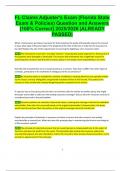FL Claims Adjuster's Exam (Florida State
Exam & Policies) Question and Answers
[100% Correct] 2025/2026 |ALREADY
PASSED|
When a homeowner purchases insurance for their property, the policy will typically require the insured
to have what type of financial stake in the property at the time of the loss in order for the insurance to
be valid? Explain the role of this requirement in ensuring the legitimacy of an insurance claim.
The homeowner must have "insurable interest," meaning they would experience a financial loss if
the property were damaged or destroyed. This ensures the homeowner has a legitimate reason for
purchasing the insurance and that the insurance policy is not simply a form of gambling on an event.
Describe the characteristics of an insurance policy as a contract. How does it differ from other types of
contracts, particularly in its treatment of ambiguous terms or provisions?
An insurance policy is considered a contract of adhesion, meaning the terms are typically written
by the insurer, and any ambiguities are generally resolved in favor of the insured. This protects the
insured, as they usually have unequal bargaining power compared to the insurer.
If a person has an insurance policy for their car and then sells the vehicle to another party, why might
the buyer not be able to take over the existing insurance coverage? Discuss why the insurance contract is
considered personal to the policyholder.
Insurance policies are contracts of personal nature, meaning the coverage is tied to the individual
policyholder. Since the risk is assessed based on the original policyholder’s characteristics, the buyer
would need to purchase their own policy, as the original coverage cannot be transferred.
Explain the principle of indemnity in insurance and how it ensures that the insured is not unfairly
enriched after a covered loss. What role does this principle play in maintaining the fairness and integrity
of the insurance system?
The principle of indemnity ensures that an insured person is compensated only to the extent of
their loss and does not profit from the event. This principle helps to keep the insurance system fair,
ensuring that payouts are only intended to restore the insured to their previous financial position, not to
provide an opportunity for financial gain.
1
, A homeowner’s property is valued at $100,000, and the homeowner has an insurance policy covering
80% of this value. After a partial loss of $20,000 occurs, how much will the insurance company pay for
this loss? Discuss the effect of the coinsurance clause on the payout.
Given the homeowner has coverage for $80,000 (80% of the $100,000 value), the insurance
company will calculate the payout based on the coinsurance formula. Since the insured has met the 80%
requirement, they will receive the full $20,000 for the loss, less any deductible, ensuring they are
covered adequately under the policy's terms.
Under a standard homeowners policy, there are various types of property exclusions. If a policyholder's
personal belongings, such as jewelry, are stolen, how does the policy determine whether this loss is
covered, and what limitations might apply to items like jewelry?
Under a typical Homeowners (HO-3) policy, there is a limit on coverage for personal property,
including jewelry. While jewelry may be covered, the coverage is usually capped at a specific amount,
often $1,500, unless the homeowner has added an endorsement for higher limits. The policy’s exclusions
and limitations ensure that coverage is tailored to common risks.
What are the typical conditions that must be met in order for a dwelling policy to cover unattached
structures, such as a garage or shed? How are these structures typically covered in relation to the value
of the primary residence?
In most dwelling policies, unattached structures are covered under Coverage B, which is typically a
percentage of the coverage amount for the primary residence. For example, Coverage B may provide up
to 10% of the dwelling’s coverage limit to insure unattached structures, ensuring that structures like
sheds or garages are adequately covered for loss or damage.
Describe the factors that influence the premium of a Homeowners policy. How do rating factors like the
location of the property, its construction type, and the risk of natural disasters affect the cost of
insurance coverage?
The premium for a Homeowners policy is influenced by factors such as the location of the
property (areas with higher crime rates or natural disaster risks may result in higher premiums), the
construction type (materials and design impact the likelihood of damage), and the property's proximity
to fire protection services. These factors help insurers assess the risk and set premiums accordingly.
A contractor has a set of tools, including a welder, that are at risk of being stolen while on a job site. How
can the contractor protect these tools with an inland marine policy, and which specific form of coverage
would be appropriate for this type of exposure?
The contractor can use a contractor's equipment floater under an inland marine policy, which
provides coverage for tools and equipment that are portable or used at various job sites. This form of
2




